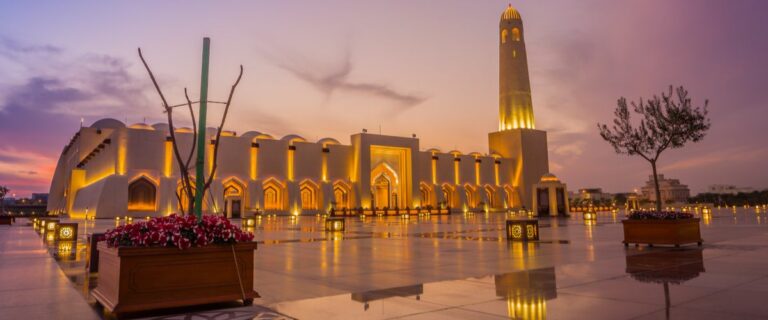Introduction: Qatar’s Geographical and Cultural Background
Qatar is a small peninsula located in the Arabian Gulf, surrounded by Saudi Arabia to the south and the Persian Gulf to the north, east, and west. Its location and climate have played a significant role in shaping Qatari cuisine. The country has a rich heritage and culture, with a unique culinary tradition that reflects the diverse influences of its history.
Qatar’s strategic location on the trade routes between Asia, Africa, and Europe has made it a melting pot of cultures, with a history that dates back to the 7th century. The country’s cultural heritage is rich in Islamic traditions, Bedouin customs, and Arab hospitality. This rich blend of cultures and traditions has influenced the way Qatari cuisine is prepared and enjoyed today.
Influences of Qatar’s Geographical Location on Qatari Cuisine
Qatar’s geographical location has influenced the types of food that are available and the way they are prepared. The country’s warm and arid climate has led to the cultivation of hardy crops like dates, figs, and watermelons, which are used in many traditional Qatari dishes. The country’s proximity to the sea has also influenced its culinary traditions, with seafood featuring heavily in many Qatari recipes.
The desert climate has also influenced the cooking techniques used in Qatari cuisine, with many dishes slow-cooked over an open fire or in a clay oven. The Bedouin tradition of cooking under the ground in a pit oven, known as “tannour,” is still practiced in some parts of Qatar today.
Cultural Heritage: A Major Influence on Qatari Cuisine
Qatari cuisine is deeply rooted in the country’s cultural heritage. The Bedouin tradition of hospitality is an essential aspect of Qatari cuisine, with guests often welcomed with a cup of sweet, spiced tea and dates. Many traditional Qatari dishes, such as machboos (spiced rice with meat or fish) and thareed (bread and meat stew), are served in large communal platters, which are shared among family and friends.
The Islamic traditions of Ramadan and Eid al-Fitr also play a significant role in Qatari cuisine. During the holy month of Ramadan, families gather to break their fast with a meal known as iftar. Traditional dishes such as harees (cracked wheat porridge) and qatariya (sweet cake) are served during this time.
Ingredients and Flavors Unique to Qatari Cuisine
Qatari cuisine features a range of unique ingredients and flavors that are used to create the country’s traditional dishes. Spices such as saffron, cinnamon, and cardamom are commonly used to add flavor and aroma to dishes like machboos and saloona (vegetable stew).
Dairy products such as laban (yogurt) and balaleet (sweet vermicelli) are also commonly used in Qatari cuisine. Dates, which are a staple crop in Qatar, are used in both savory and sweet dishes and are a symbol of hospitality in Qatari culture.
Traditional Qatari Dishes: A Reflection of the Culture
Qatari cuisine is a reflection of the country’s rich culture and history. Many traditional Qatari dishes are slow-cooked over an open fire or in a clay oven, reflecting the Bedouin tradition of cooking in the desert. Dishes such as thareed and harees are also a reflection of the country’s Islamic traditions, with both dishes having a history that dates back to the time of the Prophet Muhammad.
Modern Influences on Qatari Cuisine and Food Culture
In recent years, Qatar’s food culture has been influenced by the country’s growing economy and diverse population. The country’s multicultural society has introduced new ingredients and cooking styles to Qatari cuisine, such as Indian and Pakistani spices and techniques.
The rise of gourmet dining and the growth of the tourism industry has also had an impact on Qatari cuisine, with many restaurants now offering contemporary takes on traditional Qatari dishes. Despite these modern influences, Qatari cuisine remains deeply rooted in the country’s cultural heritage, with traditional dishes and cooking techniques still celebrated and enjoyed by locals and visitors alike.

